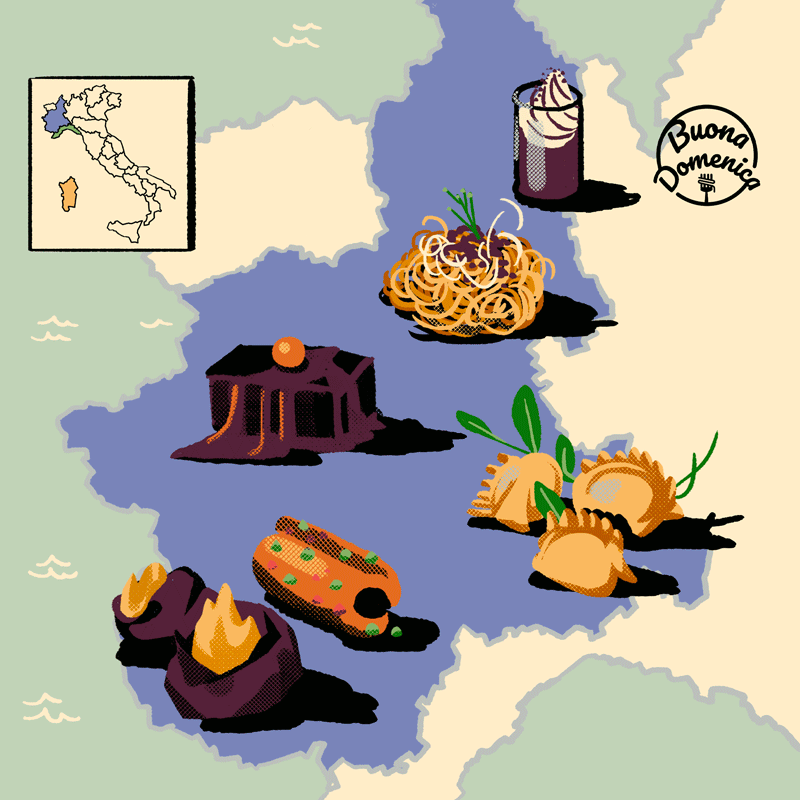
NOTE: To view this newsletter in its entirety, please click on the headline to call it up in your browser.
WELCOME to Buona Domenica, a weekly newsletter of Italian home cooking and baking. I’m a journalist, cooking teacher, occasional tour guide, and author of eight cookbooks on Italian cuisine.
FOOD WRITERS IN PIEMONTE, FALL 2025: Kathy Gunst and I have added a second Food Writers in Piemonte workshop to our 2025 schedule. This five-day workshop and tour will take place Oct. 3-8, 2025. The itinerary will be similar to our sold-out May workshop. If you are interested in this small-group experience, please send me an email at domenica@domenicacooks.com for more information.
This week’s newsletter features food highlights of my recent travels through Liguria, Piemonte, Cagliari, Sardegna, and Lombardia.
Click here to browse through the newsletter archive. If you’re looking for a particular recipe, you’ll find all Buona Domenica recipes—172 and counting—indexed here, ready to download and print—a function for paid subscribers. If you are able to do so, please consider supporting my work by becoming one.
If you enjoy this weekly newsletter, please click on the ❤️ icon to like this post. This one gesture really helps to spread the word, and I appreciate it.
Some of you will remember that I spent several weeks last summer traveling through southern and central Italy doing research for a new cookbook I’m working on. This October has taken me north, from Liguria and Piemonte to Lombardy, with an all-too-brief hop over to Sardegna in between. By the time you open this newsletter, I will be in Trento, in the northeast of the country.
What’s become clear over these last few months of bouncing around from region to region and province to province, from the city to the countryside, and from the seaside to the mountains, is this: One lifetime is not enough to know Italy. I feel more convinced of this than ever. Italy may be a small country, but each region seems vast, somehow, infinite in the treasures it holds within its lands, its enduring traditions and rituals, its food and wine. Whenever I am here, something new is revealed. When I wrap up a trip, whether it’s a tour or research or just vacation, I feel both inspired by everything I’ve learned (and consumed) and overwhelmed by all that’s left to learn about these places.
And that’s about where you find me right now. Which is to say, my brain is a jumble. I have yet to digest all the facts and impressions of the last three weeks on the road, and I am still on the road. However, in a few days I’ll be back at my house in Abruzzo to decompress, dump notes (as we reporters like to say) and process it all. And do laundry. In the mean time, I wanted to share a handful of food highlights—dishes that made me appreciate the depth, diversity, and whimsy of Italian cooking all over again. Some are from my week of touring with a small group of guests (great group!) through the Langhe hills of Piemonte and into Liguria and the Italian Riviera. Others are from my research travels. I’m not including Trento in this roundup because I only just got here—though I have already determined that spatzle and apple strudel figure prominently!
I’ve compiled this list according to food category (pastas, second courses, etc.). Please let me know if there’s anything you see that you’d be interested in learning how to make. I’m thinking for future newsletters, but also possibly for Zoom classes, something I’ve been wanting to resume.
FOUR STUFFED PASTAS
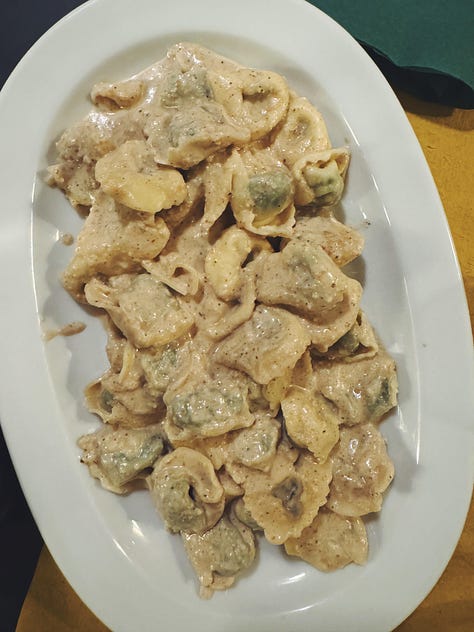

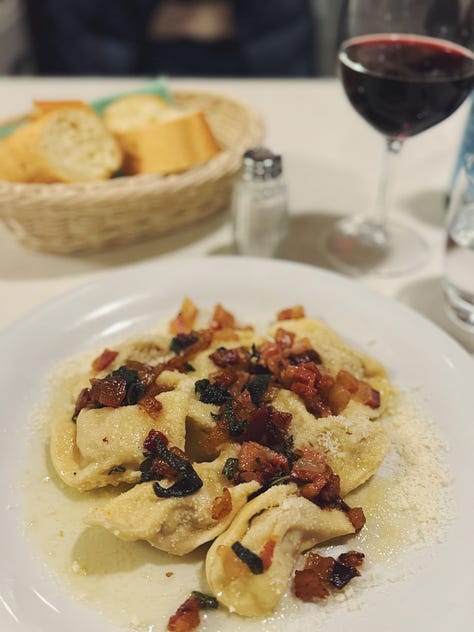
1. Pansoti: Yes, Liguria is the land of emerald-hued trofie al pesto. But these chubby ravioli—pasoti translates to ‘little bellies—might be my favorite Ligurian pasta. The light dough contains white wine and the filling is a mix of herbs and tender greens, Parmigiano cheese, and a fresh, spoonable, slightly sour local cheese called prescinseua. Pansoti are traditionally dressed with Salsa di Noci, a creamy walnut sauce flavored lightly with garlic and marjoram. We enjoyed these on our tour during our dinner at Il Genovese, the popular restaurant owned by Roberto Panizza, pesto ambassador to Liguria and the world (you can read about Roberto in my book Preserving Italy).
2. Agnolotti del Plin: These tiny meat-filled ravioli are a Piemontese specialty. They look like miniature envelopes thanks to the particular way that the filled strip of dough is pinched before being cutting the ravioli—“plin” means pinched in the local dialect. With its Piemontese cattle, its no surprise that this region is rich in meat-based dishes—which, coincidentally, happen to pair well with Barolo and all the other lovely wines of the Langhe hills. Fittingly, our group enjoyed these during a tour and luncheon at Giovanni Rosso winery. The pasta is made with an egg-rich dough, and the filling is typically composed of finely chopped roast meat and greens—though nowadays minced/ground meat is also used. To sauce: either the juices from the roasted meat (traditional) or butter, sage, and Parmigiano cheese. I’ve made these in online classes, a class I’d be happy to reprise!
3. Culurgiones (not pictured): In Cagliari, the capitol of Sardegna, I finally tasted this uniquely shaped stuffed pasta that has become so popular on social media. The filling of potato, mint, and pecorino cheese is enclosed in a fat teardrop-shaped dumping that is pinched shut to form a herringbone pattern—”chiusura a spiga,” as the method is called. Unfortunately, the photo I (surreptitiously) snapped at the restaurant where I had these turned out terribly, but you can see what they look like here. Tomato sauce is the traditional condimento for culurgiones, but mine were sauced with crema di fiore sardo, a creamy sauce made with the island’s pecorino cheese.
4. Casoncelli alla Bergamesca: These win the prize for richest stuffed pasta. They are the typical pasta of Bergamo, a truly stunning city of brown and grey and cream stone. The old, walled city, known as Città Alta, sits on a hill just south of the Alpi Orobie, with the modern city sprawled out below. A shop keeper in the old town directed me to Antica Trattoria La Colombina, which still makes casoncelli by hand. The half-moon ravioli are lightly folded and pressed down in the center to form a groove, possibly to better hold sauce, though I’m speculating here. The filling is a mix of meats, including something called “pasta di salame.” This is a mix of ground pork and spices that is used to make the area’s local salami. Other ingredients include sultana raisins and sometimes amaretti. As if that weren’t rich enough, the pasta is dressed in a sauce of sautéed pancetta and its drippings, butter, sage, and grated Grana Padano cheese.
SECOND COURSES

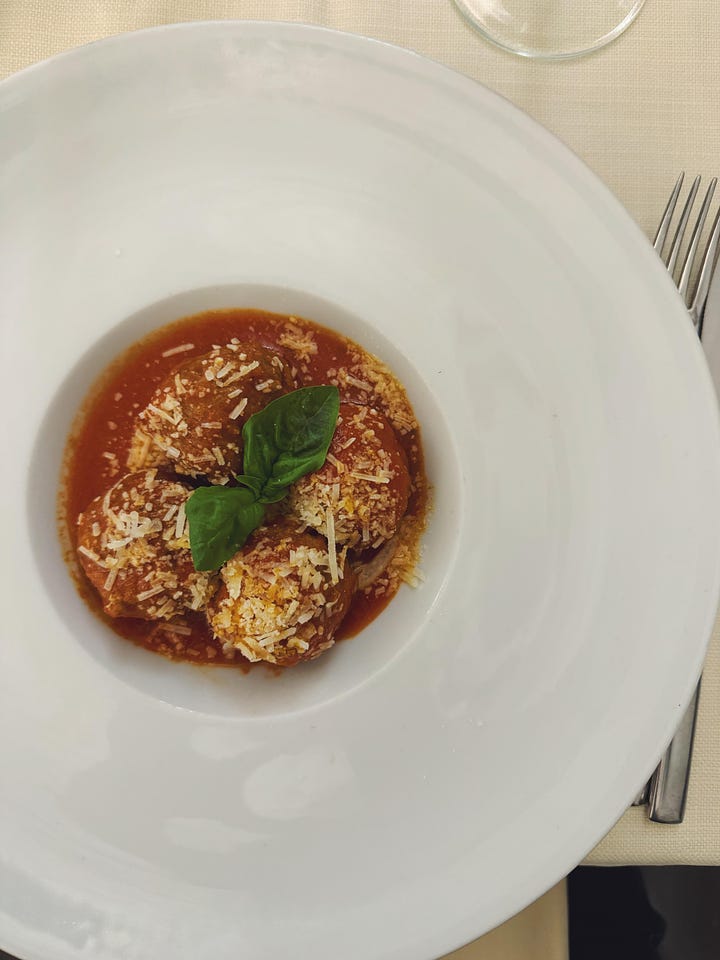
1. Vitello Tonnato and Insalata Russa: I’ve put this in the ‘second courses’ category even though it was served to our tour group as an antipasto, as part of our Piemonte winery luncheon. I, however, would happily serve it as a second course in summer and early fall. Vitello tonnato, called Vitel tonné in dialect, is one of Piemonte’s most traditional dishes. It consists of very thinly sliced poached round of veal accompanied by a punchy creamed sauce of tuna, capers, anchovies, hard-boiled egg yolks, oil, lemon juice, and vinegar. I tried to make this once years ago and it was a disaster—the meat fell apart and had no flavor. I’d been reluctant to try it again, but this most recent taste might be the spur I needed to give it another go. The scoop of insalata russa on the side was, for me, a chef’s kiss. My aunt Elsa used to make this and I love it. It’s a mix of neatly diced cooked and raw vegetables and pickles (gherkins), plus hard-boiled eggs, bound with homemade mayonnaise. It is often served frosted with a thin layer of mayonnaise and garnished with slices of egg and vegetables cut into pretty patterns. While it’s not to everybody’s taste, those who love it really LOVE it.
2. Bombas: These zesty Sardinian meatballs, which I had at Su Domu Sarda, in the heart of Cagliari, are made with a specific breed of Ox called Sardo-Modicana, also known as bue rosso (red ox) for the reddish color of its mane. The meat is like beef with extra-oomph. The meatballs contain lots of pecorino, and are fried, then dressed with tomato sauce, fresh basil, and more cheese. These were among the best meatballs I’ve ever had, not too bready, tender but not mushy, and packed with flavor.
FOCACCIA


1. Focaccia al Formaggio: Originating in the city of Recco, on the Italian Riviera, this unique cheese-filled flatbread is now made throughout Liguria. Like pizza Napoletana, real Focaccia di Recco has DOP status; it must conform to a set of criteria in order to be called “focaccia di Recco.” Otherwise, it’s called “focaccia al formaggio.” Even the New York Times wrote about this oozy delight recently. During the Ligurian swing of our culinary tour, we had the pleasure of watching Delia, the breadmaker at La Rotonda restaurant, in Camogli, make one for us. (I recorded the entire process, and will try to post it for paid subscribers once I’ve had a chance to edit it.) To make focaccia di formaggio, you must stretch the soft dough paper-thin, as though you were making strudel. The sheet is fit into a large pan, dolloped generously with creamy stracchino cheese, and covered with a second paper-thin layer of dough. The whole is baked, sliced up, and served hot out of the oven.
2. Focaccia di Delia: In addition to the cheese focaccia, Delia brought out thick slices of another focaccia she made. I’ve named it ‘focaccia di Delia’ because I’ve never had anything like it. It was taller than typical Genovese focaccia, very tender and dense and buttery (no butter, though!). I could have sworn the dough had mashed potato in it, like Barese-style focaccia. But Delia said no; just a mix of flours, oil, yeast, water, and salt. She was kind enough to share her recipe with me, and as soon as I’ve had a chance to try it, I’ll share it—if it’s as good as hers!
TORTE SALATE

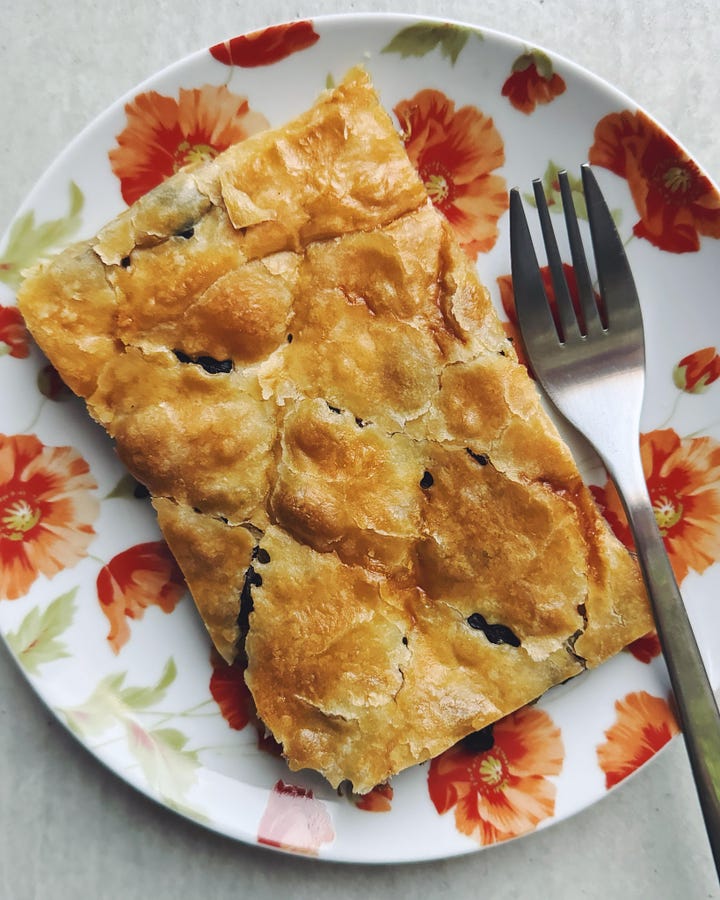
These were a last-minute addition to this post, but they were so good I did not want to leave them out. While in Bergamo, I happened upon a salumeria in the Città Alta that has been in operation since 1921. Two savory tortes graced the display case in the window: Torta Valdostana, a layered affair of mortadella, prosciutto, fontina, and eggs; and Torta di Carciofi (pictured above on the left), generously filled with artichokes, cheese, and eggs. I took a slice of the latter back to my apartment and had it for dinner. The artichokes were not the jarred or frozen kind, but rather freshly cooked; the cheese was lightly pungent; and the eggs served as a binder. The dough was some sort of pasta sfoglia (puff pastry), possibly homemade. The other slice I bought at a shop in Crema, a picturesque Lombard city made famous as the setting for the film Call Me By Your Name. It, too, was made from puff pastry dough, with a Southern Italian-style filling of sautéed escarole, chopped black olives, sultanas, and capers. I can’t say that either of these tortes was typical of Lombard cuisine—savory tortes are more of a Ligurian tradition—but both were excellent renditions, and I am putting them on my “to make” list, which continues to grow faster than I can keep pace with.
DOLCI
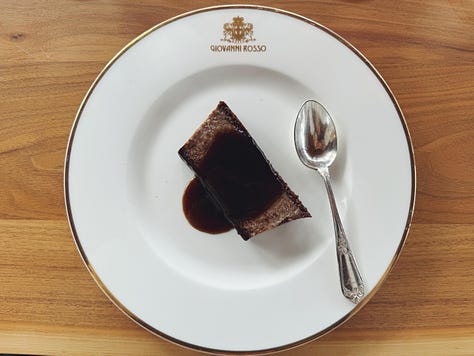
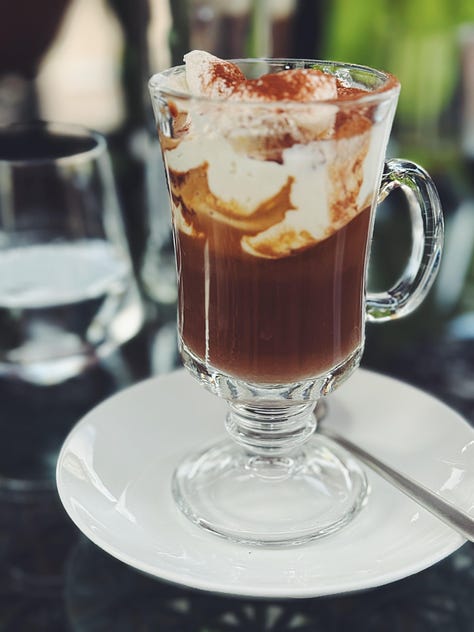

I suppose it’s only fitting that my favorite three desserts of these last few weeks have all come from Piemonte, land of chocolate. The region’s relationship with chocolate dates to the 16th century, when Torino was made the capital of the Savoy Duchy, and Emanuele Filiberto di Savoia “served” a symbolic cup of hot chocolate to the city in celebration. In the 17th century, Torino’s chocolatiers began experimenting with ways of mixing chocolate and other ingredients to form pastes and, eventually bars.
1. Bonet: To call this dream dessert a flan is to minimalize its wonder. Yes, it is a flan-like dessert, which is to say a baked custard. But bittersweet chocolate (cocoa powder) and crushed amaretti transform it entirely, and chocolate and almond are such a fine combination. It’s decadent, to say the least.
2. Bicerin: If you go to Torino, one of Italy’s most elegant cities, be sure to sit down at a caffè for a Bicerin. This drink-dessert is the city’s specialty, a concoction of espresso, bittersweet melted chocolate, milk, and a lush topping of heavy cream. It is meant to be enjoyed hot, and best to take the long spoon with which it is served and plunge it down into the depths of the glass to get a spoonful of both the coffee-chocolate mixture and the densely whipped cream topping.
3. Gelato al Cioccolato e Barolo Chinato: Nocciola (hazelnut), gianduja (chocolate-hazelnut), and pistachio are my three go-to gelato flavors. But a gelateria in La Morra, in the heart of the Barolo area of Piemonte, serves a wonderful flavor made from extra bittersweet chocolate mixed with Barolo Chinato. I had to try it. Barolo Chinato is an enhanced wine made with Barolo and laced with aromatic herbs and china bark (quinine). It’s become quite popular in the last decade or so, and is recommended as an after-dinner cordial. I can tell you it makes fantastic gelato. The other flavor I chose was chestnut, which is only available seasonally. The two together had me doing a little dance.
I can’t decide whether I’m famished or full after writing this, but in any case I hope these highlights have whetted your appetite. Please share your own food highlights from trips to Italy or elsewhere.
Thanks, as always, for reading, subscribing, and sharing.
Alla prossima,
Domenica





Fun! Anyone know how. to adjust the audio voice? This version male which feels
different than having Dominica reading it to us !
After reading your piece, I have an uncontrollable desire to jump into the kitchen and prepare Pansoti and Agnolotti del Plin. It's been at least 10 years since I've had both gems...
The regional food maps are quite nice.